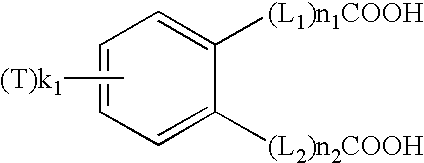Photothermographic material
a technology of thermoplastic materials and thermoplastics, applied in the field of thermoplastic materials, can solve the problems of not using such organic solvents as solvents, adversely affecting human bodies during manufacturing processes, disadvantages in terms of costs, and rendering coatings unavailable with a surface having a practically durable quality
- Summary
- Abstract
- Description
- Claims
- Application Information
AI Technical Summary
Benefits of technology
Problems solved by technology
Method used
Image
Examples
example 1
(1) Production of PET Support
Using a terephthalic acid and an ethylene glycol, according to a normal method, a PET of IV (intrinsic viscosity)=66 (measured at 25.degree. C. in phenol / tetrachloroethane=6 / 4 (ratio by weight)) was obtained. After this was made into pellets, they are dried for four hours at 130.degree. C. After extruded from a T-shape die after melted at 300.degree. C., the material was rapidly cooled, and non-drawn film was produced with a thickness such that the film thickness after getting thermal stability was 120 .mu.m.
This film was longitudinally drawn 3.3 times using rollers having different peripheral speeds from one another and transversely drawn 4.5 times using a tenter. At that time, the temperatures are 110.degree. C. and 130.degree. C., respectively. Then, 4% relaxation was made in the transverse direction at the temperature of 240.degree. C. after thermally stabilizing the film at the same temperature for 20 seconds. Subsequently, the chuck of the tenter w...
PUM
 Login to View More
Login to View More Abstract
Description
Claims
Application Information
 Login to View More
Login to View More - R&D
- Intellectual Property
- Life Sciences
- Materials
- Tech Scout
- Unparalleled Data Quality
- Higher Quality Content
- 60% Fewer Hallucinations
Browse by: Latest US Patents, China's latest patents, Technical Efficacy Thesaurus, Application Domain, Technology Topic, Popular Technical Reports.
© 2025 PatSnap. All rights reserved.Legal|Privacy policy|Modern Slavery Act Transparency Statement|Sitemap|About US| Contact US: help@patsnap.com



